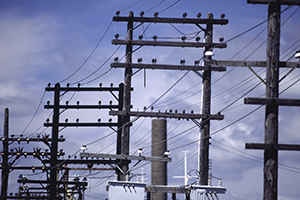Electric Power Line Installation and Repair Meeting Kit

WHAT?S AT STAKE ÿ
Electric power line workers install, maintain, and repair electric networks between power plants and their customers. This work is hazardous; contact with high-voltage power lines can instantly electrocute you. Get proper training and safety equipment such as insulated protective clothing and tools.
WHAT?S THE DANGER
HAZARDS OF ELECTRIC POWER LINE INSTALLATION AND REPAIR
- Overhead high voltage transmission lines are not insulated and if a person comes in contact or even closer to them through a ladder, crane, truck or any other means, he may get a life-threatening electrical shock
- Sometimes due to any fault or other factors electricity from these lines can flow to ground through the equipment or a person. It can cause serious injuries or death to that person.
- Electricity can flash over a gap, so any equipment or a person at some distance from the power lines can still be in danger.
- During storms or strong winds, overhead electric lines may fall to the ground and thus create danger in the surrounding.
- Working at heights on overhead power lines is not safe as an operator may fall to the ground if not properly equipped with relevant PPE (personal protective equipment).
- Underground power lines can also be hazardous during digging works. An operator not armed with appropriate PPE may mistakenly come in contact with the conductor causing a deadly electric shock.
HOW TO PROTECT YOURSELF
THE WORK ENVIRONMENT OF POWER LINE INSTALLER AND REPAIRER
Electrical power-line installers and repairers typically work outdoors. Their work involves driving or riding in trucks that hold the equipment they need. They also climb power poles to inspect the lines. The work also involves them working on building exteriors to connect lines, which can be high on the buildings. They can also use trucks with a lift to help them reach higher lines.
DAY TO DAY TASKS OF ELECTRIC POWER LINE INSTALLERS AND REPAIRERS
- Laying or installing power lines.
- Installing electrical distribution equipment, such as transformers.
- Repairing and maintaining the power lines and electrical equipment.
- Assessing the lines and equipment currently in-use.
- Identifying when the lines and equipment need maintenance.
- Connecting power lines to electricity poles and buildings.
HOW ELECTRIC POWER LINE INSTALLERS AND REPAIRERS AVOID INJURIES
- Only qualified electrical workers can work on energized conductors or equipment connected to energized high-voltage systems (equal or greater than 600 volts). CalOSHA defines a qualified electrical worker as a person with at least 2 years of training and experience.
- Don?t work alone on high-voltage systems. A qualified electrical worker or experienced employee-in-training needs to be available in case of an emergency. Some exceptions: replacing fuses, operating switches, or other operations on de-energized conductors or equipment, clearing “trouble” tickets, or in life threatening emergencies.
- Power lines are connected to utility poles and towers or located underground in trenches and vaults. During installation, workers use construction equipment such as augers, trenchers, diggers, cranes, etc. Get training on construction equipment you use.
- Know and understand the hazards of trenching and engulfment. Know how to dig, maintain, barricade, and enter a trench safely. Get training in confined spaces if you enter work vaults or power utility holes. Monitor the environment for hazards and have the safety equipment and backup team necessary to ensure your safe exit. Use proper lockout/tagout procedures.
- If you work from heights on power poles or towers, get training in fall protection equipment and safety and rescue procedures. Know how to hoist your materials safely. Learn the safe operation of bucket trucks that access elevated job tasks. Wear properly inspected and maintained fall protection equipment.
- Hand and power tools, along with chemical epoxies and cleaners are used to install and maintain network equipment (transformers, circuit breakers, switches, fuses, etc.). Use and maintain your tools properly. Get training in the safe handling and disposal of chemicals; consult the safety data sheet (SDS) for additional guidance.
- Power line work occurs year-round and often in remote areas, during bad weather or natural disasters, to repair and restore power in emergencies. Work with backup employees when you can. Communicate your location and expected return time with your coworkers. Wear light layers that protect you from the elements. Use reflective gear to keep you visible along roadways.
TRAINING FOR THE EMERGENCY ACTION PLAN
Training in a roll-out of an emergency action plan is fundamental for the safety of management and workers.
Worker Training. This includes the following areas:
- Identification of high-risk activities and equipment.
- Methods to eliminate/reduce contact risks.
- OSHA and other requirements.
- Overall emergency action plan and procedures.
- Power line contact emergency response.
FINAL WORD
Management should receive more thorough training on hazard mitigation and the overall emergency plan. Workers should be more thoroughly trained in emergency response and job site specific requirements. Workers need to know about the company’s overall emergency plan in case it needs to be implemented.